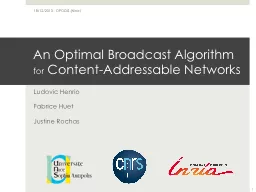

Broadcast Algorithm for Content Addressable Networks Ludovic Henrio Fabrice Huet Justine Rochas 1 18122013 OPODIS Nice Background Efficient Algorithm Experiments 2 General Motivation RDF Storage ID: 201760
Download Presentation The PPT/PDF document "An Optimal" is the property of its rightful owner. Permission is granted to download and print the materials on this web site for personal, non-commercial use only, and to display it on your personal computer provided you do not modify the materials and that you retain all copyright notices contained in the materials. By downloading content from our website, you accept the terms of this agreement.
Slide1
An Optimal Broadcast Algorithm for Content-Addressable Networks
Ludovic HenrioFabrice HuetJustine Rochas
1
18/12/2013 - OPODIS (Nice)Slide2
BackgroundEfficient AlgorithmExperiments
2Slide3
General Motivation – RDF StorageContextWeb Semantic: RDF data
ChallengeStore and retrieve RDF data
Large scale setting
Our solutionContent Addressable Network
3Slide4
Content-Addressable Networks (CAN)Overlay networkNodes
are peers
A
E
B
C
D
0
1
1
d
im
#1
d
im
#2
4
Structured
organization
Multidimensional
Cartesian
space
Entirely
partitioned
Each
zone
managed
by one
peer
A zone = a (hyper)rectangle
Neighborhood
based
on adjacent
zonesSlide5
Problem: Cost of Queries
5
2
queries
over 2 variables: conjunction of two 2-dimensional broadcast
1
query
over 2 variables
1
query
over 1 variable
N
aive
broadcast
does
not
scaleSlide6
Duplicated messages11 peers 40 messages !How to eliminate
duplicates?For each peer P
Find the peer that
is reponsible
for sending the message to P
E
0
1
1
d
im
#1
d
im
#2
Problem
:
D
uplicated
Messages
6Slide7
Existing SolutionsUse the CAN structure to route messagesMeghdoot
[1] « upperLeft » predicateM-CAN [2]M-CAN principles
Initiator peer sends
to all neighborsOther
peers forward to neighbors on
Same dimension on opposite side
Lower
dimensions
on all
sides
Forwarding
on the last dimension
depends
on a
constraint
7
[1] A. Gupta, O. D
.
Sahin
, D.
Agrawal
, A.
El
Abbadi
:
Meghdoot
: Content-Based Publish/Subscribe over P2P
Networks. Middleware 2004
Meghdoot
:
start
from
a corner
A
B
CSlide8
M-CAN Execution
INIT
8
Corner
Constraint
Message
Message
that
leads
to duplication
[2] S.
Ratnasamy
, M. Handley
,
R. M
. Karp,
S.
Shenker
: Application-Level Multicast Using Content-Addressable Networks
.
Networked
Group Communication 2001Slide9
Preliminary
Work
Existence of an optimal algorithm proved [3]
A solution to exhibit existenceValid for a
very generic definition of CANNot efficient
Parallelize
messages
sending
only
when
reaching
a « border »
9
INIT
[3] Francesco
Bongiovanni, Ludovic
Henrio
: A
Mechanized
Model for CAN
Protocols
. FASE
2013Slide10
BackgroundEfficient AlgorithmExperiments
10Slide11
Hypothesis and GoalsCAN = adjacent rectanglesNo
additional structureTolerate churns between
two Bcast
Not implementation-dependentDo not
tolerate churns during Bcast
Optimal in number of messages
and good
parallelization
11
A
spanning
tree
INITSlide12
Efficient Algorithm – PrincipleRemoves all duplicates
In all dimensionsHow ?Uses the corner constraintPlus a spatial constraint
A set of fixed values
Reduce the problemApplies
recursively
12
s
patial
c
onstraint
in 3D CAN
s
patial
c
onstraint
in 2D CANSlide13
Observation
#1
Easy
to forward in 1DObservation #2Only one zone touches a corner
Idea of the algorithmSuppose an efficient broadcast in dimension
N
Apply
on a
hyperplane
of dimension
N - 1
Send
to
both
sides
of
this hyperplane using the corner constraint
Efficient Algorithm
13Slide14
Efficient Algorithm – Execution
INIT
14
Corner
Constraint
Message
Message
that
leads
to duplication
Spatial
ConstraintSlide15
Efficient Algorithm – PropertiesProved
to be correctAll peers receive
a broadcast message at
least onceProved to
be minimalAll peers
receive a broadcast message at
most
once
Elements
of proof –
W
hen
receiving
on dimension D:
dim < D
contains spatial constraint
For dim
= D ascending or
descending direction dim > D
checks corner constraint
15
This
algorithm
is
optimal
All
peers
receive
a
broadcast
message
exactly
onceSlide16
BackgroundEfficient Algorithm
Experiments
16Slide17
Experimental SetupUsing the Grid5000 platformMultisite
experimentationDeployment From 50 to 1500 peers
Up to 200 physical machinesCAN setting
Successively split zones in
halfZone to split is chosen
randomly
17Slide18
Number of messages
18
Maximum gain
of 5.3 MBSlide19
Number of messages
19Slide20
Execution Time
20
Significant
speedup
Slide21
Conclusion: Broadcast on CANWe found an optimal solution
Proved to be correct
and optimalEfficient on large scale
settingsSupport range multicast
Currently in use in the EventCloud project
[4]Management of RDF data Algorithm used for one
year
Tested
and
approved
!
21
[4] http
://
www.play-project.eu
/solutions/event-cloud
EventCloud
A range multicastSlide22
Efficient Algorithm – Execution22